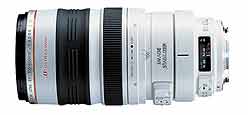|
See Also:
Canon EF Lenses
Canon EF-S Lenses
Canon IS Lenses
Canon L Lenses
|
Canon Lens Glossary
Each Canon lens is identified by a series of codes that provide important information about its unique characteristics.
Below are the main Canon identifying codes and terminology likely to be found in Canon lens descriptions:
- EF — Stands for Electro-Focus and signifies that the lens has an electronic lens mount. Since 1987 Canon SLR cameras have been designed to connect to the lens electronically.
Prior to this, connection between camera body and lens was mechanical and lenses with the mechanical lens mount carried the letters FD.
See Canon EF Lenses for more.
- EF-S — EF lenses designed to fit Canon's range of digital SLR cameras that have the smaller APS-C sensors, as in the
Canon Digital Rebels (300D to 500D) and prosumer "D" models such as the 10D to 50D, plus the new 7D.
See Canon EF-S Lenses for more.
- USM — Stands for ultra sonic motor. Technology pioneered by Canon that uses sound waves to position the lens elements when focusing to produce highly
responsive, fast and silent focusing with excellent holding torque.
- IS — Stands for Image stabilizer. Image stabilization technology allows the lens to sense movement from "shake" or vibrations and
instantly apply an optical correction by moving a group of lens elements. The improvement in steadiness can be seen in the viewfinder,
and IS lenses allow shooting hand-held or on a monopod at shutter speeds two to three stops slower than would normally be possible.
See Canon IS Lenses for more.
- L — Canon's designation for their top-of-the-range, professional lenses incorporating special optical materials such as
fluorite, ultra-dispersion (UD) or super UD elements. L-series lenses, which are branded with a red stripe around the barrel, are the
best Canon lenses available at any given focal length or zoom range and are priced accordingly. See Canon L Lenses for more.
- DO — Stands for Diffractive Optics, an optical technology developed by Canon for manufacture of telephoto lenses that
are significantly shorter and lighter than previously possible, while simultaneously improving optical performance by reducing chromatic aberration.
Canon produce two DO lenses, the EF 70-300mm f/4.5-5.6 DO IS USM zoom lens and the EF 400mm f/4 DO IS USM fixed focal length lens.
- TS-E — specialist tilt/shift lenses that allow correction of perspective distortion and control over the focus range. These lenses are often used
for architectural interiors and exteriors.
- MP-E — Denotes a lens specially designed for macro photography. There is only one MP-E lens in the Canon line-up, the MP-E 65mm f/2.8 1-5x Macro Photo.
- Macro — Denotes a Canon macro lens, also known as a close-up lens. Macro lenses have the ability to focus an image on the film or sensor
that is at least as large as the subject. This is a magnification of 1:1.
Here's an example of a comprehensive Canon lens description with brief explanation of the various numbers and letters:

EF 100-400mm f/4.5-5.6L IS USM
- EF — Canon lens with electronic mount.
- 100-400 — refers to focal length in millimeters, which relates to a lens's angle of view. The lower the number, the wider the
lens's angle of view; the higher the number, the more powerful it is at bringing distant objects closer. If there is only one number, the lens has a
fixed focal length. A number range indicates a zoom lens.
- f/4.5 - 5.6 — refers to the lens's maximum aperture or minimum "F-number", a function of the lens's aperture diameter. The lower the number,
the larger and "brighter" the maximum aperture and generally more useful the lens. A number range indicates the maximum aperture at each of the
extremes of the lens's zoom range. In the example above, the lens has a maximum aperture of f4.5 at 100mm, decreasing to f5.6 at 400mm.
- L — indicates a professional L-series lens - see above.
- IS — refers to image stabilizer - see above.
- USM — ultra sonic motor - see above.
Additional Canon Lens Terminology:
- Aspherical Elements - Unless corrected, light rays entering conventional lens elements converge at slightly differtent focal points.
Known as spherical aberraton, this phenomenon produces soft, low contrast images that look as if covered with a thin veil. Canon was the first company
to correct this error in an SLR lens by incorporating an aspherical lens element. Now found in nearly every EF lens, these special elements help deliver
corner-to-corner sharpnness and clarity.
- Super Spectra Coating - Light reflecting off lens elements and a digital camera's sensor can result in significant light loss and cause ghosting
(secondary images) and flare (washed out image). To eliminate harmful reflections, the latest EF lenses are treated with Canon's patented multi-level Super
Spectra coating which absorbs light rather than reflecting it.
- Fluorite and UD lens elements - Canon has pioneered the development of Fluorite and UD lens elements for correcting chromatic aberrations. These
aberrations are defects caused by different wavelengths or colors of light refracting by different amounts as they pass through conventional glass elements.
With their special diffraction properties, Fluorite and UD lens elements correct such aberrations to deliver high contrast, sharpness, and accurate color
reproduction.
Return to Canon Lens Reports
|

